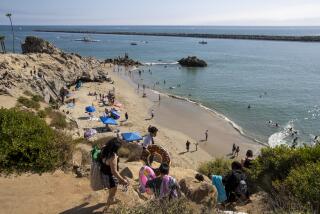SUNSET BEACH : FOCUS : In Sunset Beach, You Can Call a Tower Home
On the northern Orange County coast is a small strip of sand known as Sunset Beach. This unincorporated oceanside colony is bordered by Seal Beach to the north, Huntington Beach to the east and Bolsa Chica State Beach to the south.
Sunset Beach owes its development in the early 1900s to the Pacific Electric Railway, which provided a link between the beach cities and the more heavily populated inland areas. Local businesses, temporary bungalows and cottages began appearing as the area became a weekend retreat.
Today’s residents must make daily runs to the post office because there is no mail delivery. It’s not that they couldn’t have the service if they wanted it, but the trek provides residents with an opportunity to converse with friends and neighbors.
The fire department is composed of 22 people from all walks of life. Called paid-call firefighters, each member is paid $7 per call and a few, believe it or not, have made full-time employment out of this “calling.” Although the narrow streets and high housing density make it difficult for fire trucks to maneuver, the department will respond to any kind of household emergency.
Small-boat fanciers are enthusiastic about the boating opportunities available at the Sunset Aquatic Regional Park. The 64-acre facility is snuggled among the salt marshes of Sunset Bay. The area has a grassy park setting and outer bulkheads lined with more than 200 boat slips.
In 1940 a 75,000-gallon water tower was built in Sunset Beach, and it became a kind of landmark for the community. The tower served Seal Beach and Sunset Beach for 35 years before it was abandoned. The City of Seal Beach dropped plans for renovation after learning that the project would cost $100,000. In 1980 a group of Sunset Beach residents called “Save the Water Tower” approached George Armstrong, and asked him to buy the tower. Armstrong, a professor at Long Beach City College who had once bought another water tower, and a partner, Dr. Robert Odell Jr., bought and renovated the property. By 1984 Armstrong had moved into a unique round house 87 feet in the sky.
Although the Douglas fir and redwood tower has not held water for more than 13 years, it remains the community’s primary landmark.
Statistics Population: (1987 est.) 1,409 Median household income: $31,119 Racial/ethnic mix: white, 92.2%; Latino, 4.7%; black, 3.3%; other, 4.5% (Total is more than 100% because racial/ethnic breakdowns overlap)
Employment status Employed persons: 754 Unemployed: 34 Not in labor force: 229 Per capita income: $17,400
Population Median Age: 30.1 years
Education Adults over 25 Years of school completed: 0-11 years: 14.1% 12 years: 25.2% 13-15 years: 22.2% 16+ years: 38.5% Median years completed: 14.4
Statistics: Donnelley Demographics
More to Read
Sign up for Essential California
The most important California stories and recommendations in your inbox every morning.
You may occasionally receive promotional content from the Los Angeles Times.










